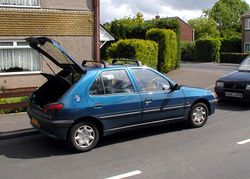Hatchback
Car Show
Hatchback
City car | Supermini car | Subcompact cars | Family car | Compact car
 Peugeot
306 Hatchback, with the hatch lifted and the parcel shelf visible
Peugeot
306 Hatchback, with the hatch lifted and the parcel shelf visibleA
hatchback is an
automobile
design, consisting of a passenger cabin which includes an integrated cargo
space, accessed from behind by a hatch or flip-up window. Hatchbacks are also
often called three-doors (two entry doors and the hatch) or five-doors (four
entry doors and the hatch) cars. Small cars often incorporate a hatchback to
make the best use of available space. Especially in smaller models, hatchbacks
are often truncated, with the hatch nearly vertical, to reduce the car's
footprint. This is an important consideration in countries where small streets
and traffic congestion are factors. Hatchbacks frequently include fold-down rear
seats, which enable a substantial portion of the interior space to be used as a
cargo area to accommodate with the current transportation needs. Usually, the
rear seat can be folded partially (for instance 1/2, 1/3 or 2/3) or completely
to expand the cargo space.
Technically speaking,
SUVs,
station wagons and
minivans can
also be classified as hatchbacks. However, the term hatchback, especially in the
U.S., is typically used in reference to small cars, with a smaller trunk than
other vehicles. There are larger hatchbacks (i.e.
Rover SD1),
which have fastback rear windows.
Hatchbacks typically have a parcel shelf: a rigid shelf covering the cargo
space that is hinged behind the rear seats and lifts with the hatch. An
alternative is a flexible roll-up
tonneau cover.
High performance variants of typical family hatchbacks are now common, known
as "hot
hatches".
History
The credit for the first hatchback is claimed by several manufacturers.
Holden of Australia fitted what could be described as hatchbacks onto its cars
in the late 1940s. The 1953 Aston Martin DB2/4 featured a top-hinged rear hatch.
Its successor, the 1958 DB Mark III, even offered a folding rear seat. However,
since less than 700 DB2/4 and Mark III hatches were built, the Aston Martin is
not universally considered the first mass-produced hatchback car. The 1954 AC
Aceca and later Aceca-Bristol from AC Cars
had a similar hatch at the back, though just 320 were built.
The first car which could genuinely be called a hatchback and produced in
masses was the
Renault 4 of 1961. This is controversial however, and some argue that the Austin
A40 which predated the Renault 4 by three years was the first. However, that car
had a split tailgate quite unlike what is generally accepted to be a hatchback.
The Renault 4 also came with a folding rear seat. Another car often credited
with being the first hatchback is the Renault 16, which was voted European Car
of the Year on its launch in the autumn of 1965. The first Italian hatchback was
the Fiat 127, which went into production during 1971. The first German hatchback
was the Volkswagen Passat (Dasher in North America) of 1973.
By the early 1980s,
most family cars produced in Europe were hatchbacks. Hatchbacks quickly became
regular winners of the
European Car of the Year award. However in some countries, especially with
larger cars where a
sedan
and (usually liftback-type) hatchback is available for the same model, the
sedans are often preferred. Same is true also in certain regions like Southern
and Eastern Europe, where some manufacturers have been forced to offer a local
sedan version of smaller cars that are sold only as hatchbacks elsewhere to
comply with the preferences of local clients.
US backlash
Despite, or perhaps because of, the hatchback design's space efficiency,
relatively few cars with this layout are available in the
United States. Some Americans view the hatchback design elements as an "econobox"
and consider this negatively in purchase decisions. Others view hatchbacks as
representing support for "green" movements which some consider "un-American",
although the recent commercial success of
hybrid models belies this. Interestingly enough, many of the
minivans
and SUVs which are
quite popular in the
United States have hatchback design elements and car companies frequently
market hatchback cars with euphemisms such as "Liftback", "Sportback", or "Sportwagon".
Similar body styles
Many
sports and
mid-sized cars are also designed using a variation of hatchback design,
sometimes called a 'liftback. Here, the hatchback is angled down over the
rear seats, and smoothly integrated into the tail of the car, resembling a
fastback or
sedan overall.
This often improves
aerodynamic performance, resulting in a reduced drag coefficient. Some of these
cars are the Opel Vectra, the Ford Mondeo and the Renault Laguna.
Saab often used the term
combi
coupé (or 'Wagonback' in the US) for their take on the concept. Even some
typical-looking
sedans
(saloons) have hatchbacks, such as the
Mazda6, Hyundai Elantra, Kia Spectra and the Saab 9000.
See also
Other body styles
Home | Up | List of cars | Vehicle size class | Microcars | Hatchback | Sedan | Station wagon | Sportive cars | Cabriolet | Convertible | Four-wheel drive | Minivan | Brass Era car | Personal luxury car | Recreational vehicle | Vintage car | Full-size vehicles | Keicars | Hybrid vehicles | Luxury vehicles | Mid-size car | Pickup trucks | Prestige vehicles | Production Electric vehicles | 2 plus 2 | Air car | Compact SUV | Concept cars | Cyclecar | Leisure activity vehicle | Limousine | Personal luxury car | Pony car | Professional car | Safety car | Show car | Sport compact | Voiturette | Green vehicles | Off-road vehicles | Steam automobiles
Car Show, made by MultiMedia | Free content and software
This guide is licensed under the GNU
Free Documentation License. It uses material from the Wikipedia.
|







